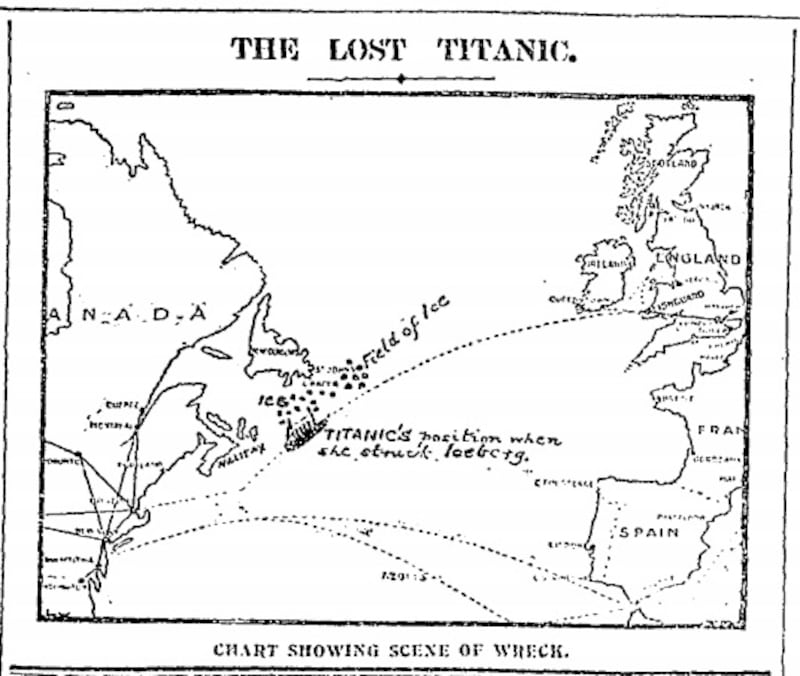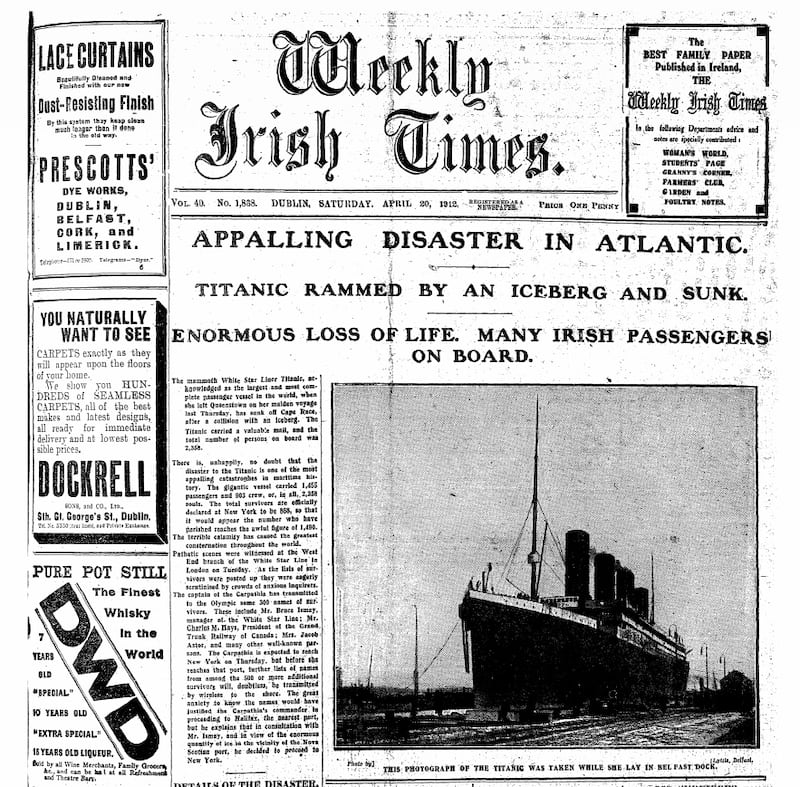In the early hours of April 15th, 1912, the British passenger liner RMS Titanic sank after hitting an iceberg in the North Atlantic Ocean late on April 14th, resulting in the loss of some 1,500 lives.
The news reached The Irish Times just as the next morning’s edition was about to go to press. The following editorial appeared on page 6 of the paper on Tuesday, April 16th, 1912.
Almost as we go to press the awful news reaches us of the loss of the Titanic with nearly seventeen hundred of the two thousand three hundred and fifty-eight passengers and crew who formed her immense burden of human life. The telegrams are brief. They upset all the reports which reached us between midday and midnight, but it is to be feared that they are true. We cannot be surprised that the public received with something like complete incredulity the first reports yesterday morning that the giant liner was sinking off the Newfoundland banks, as the result of a collision with an iceberg.
To sudden tidings of another tragedy of the sea we are only too well accustomed. But the imagination halts at the suggestion that the latest and most marvellous mechanisms of ocean traffic are exposed to dangers every whit as awful as those which lie before any tramp steamer of a few tons’ burden. “Floating palaces” is a common phrase of description for such vessels of the Titanic, or her sister-ship, the Olympic, and even vessels of much smaller size.

The Titanic was appointed throughout in a way which no hotel on solid earth could hope to rival. She had suites of luxurious apartments, carried a large staff of first-class cooks, and was fitted with spacious lounges containing all kinds of costly furniture and decorations. The sight of a swimming bath helped to convey to the mind of the traveller who wandered through her corridors the suggestion that he was in a magnificent hotel.
Sudden shock
There was nothing to remind him that he was on board ship except the far-off throbbing of the screw. We do not suppose that those who parted from the Titanic’s passengers at Southampton or Queenstown felt any more emotion than if their friends were stepping into the security of a train. We can imagine that this happy and comfortable hotel-party of hundreds of passengers were inclined to regret that their voyage across the Atlantic was nearly ended. Then, with all the horror of the totally unexpected, just before midnight, they suffered a change. Sudden shock of collision, and the largest vessel in the world lay helpless, fighting a losing battle against time, while her wireless apparatus sent out urgent messages that she was sinking and called for help.

The substantial reports which reached an anxious public throughout yesterday of the saving of the passengers and crew by means of the boats of other liner, hastily summoned by wireless telegraphy, appear to have had no foundation; their origin has yet to be explained. If it be, indeed, true that only 657 women and children have been saved out of the ship’s immense passenger list, this is one of the supreme tragedies of the sea.
The loss of the Titanic finally disproves the confident assertion that her system of watertight compartments made her absolutely unsinkable. It is hardly profitable to speculate at present upon the causes of the collision. But this accident, following upon the collision between the Olympic and HMS Hawke, seems to lend colour to the theory then put forward that the suction of such enormous vessels exposes them to a danger hitherto unknown.

These two accidents to the largest vessels in the world must give pause to naval architects who scout the suggestion that the very size of modern vessels may be a source of weakness to them. It is, at least, certain that misfortune has dogged the steps by which the tonnage of liners has increased to that of the two largest examples that the world has yet known.
The Olympic had to be returned shortly after completion to the hands of her builders. Her sister-ship, whose building cost more than that of a Dreadnought, has ended her maiden voyage at the bottom of the Atlantic.









